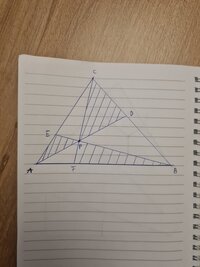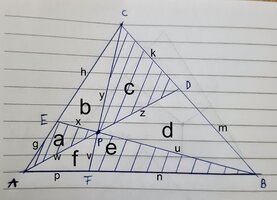MaxMontgomery
New member
- Joined
- Mar 18, 2023
- Messages
- 6
Draw three lines through a random interior point P in triangle ABC. The three lines divide up the triangle into six smaller triangles as shown in the picture. Prove that every other triangle (shaded area) is equal to the non shaded area or you could say half the area of the ABC triangle.
I have been working on this problem for around 2 weeks now and tried many different approaches, but i ultimately couldn't prove this. I would be very thankful if someone could help me with this problem.
I have been working on this problem for around 2 weeks now and tried many different approaches, but i ultimately couldn't prove this. I would be very thankful if someone could help me with this problem.


